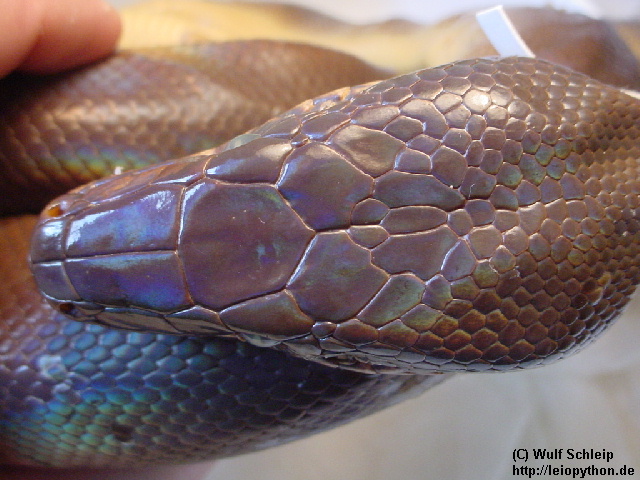Content L. montanus <--> L. huonensis
L. montanus <--> L. huonensis
Species
Leiopython fredparkeri Schleip, 2008

Common name
Fred Parker's White-lipped python, Karimui White-lipped python
Holotype
A large male collected by F. Parker 7 July 1967 at Karimui, Chimbu District, CAS 118906.
Description of the holotype
Total length about 1,620 mm; 13/13 supralabials, first and second pitted, fifth and sixth entering the orbit, having a lateral depression; 17/17 infralabials with 8–13 pitted; single loreal and preocular; 3/3 postoculars; 1/1 subocular separating the seventh supralabial from the orbit; single pair of prefrontals; two pairs of parietals, anterior ones larger and in median contact, but do not meet the postoculars, posterior ones elongate and separated by an elongate interparietal at the median; two smaller interparietals bordering anterior parietals posteriorly and the elongate interparietal anteriorly; dorsal midbody scale rows 50; ventrals 266; single anal scale; subcaudals 65, mostly paired. Parker (1982) did not explicitly mention the coloration of live specimens from Karimui, but according to D. G. Barker (pers. comm.), these specimens are very dark in color.
Diagnosis
Leiopython fredparkeri differs from Leiopython albertisii and Leiopython biakensis in the absence of the whitish postocular spot, and in higher infralabial counts. It further differs from the former species by lower ventral counts. This species is distinguishable from Leiopython montanus by loreal, prefrontal, and lower average postocular scale counts, from Leiopython huonensis by the absence of the whitish postocular spot, and from the latter species and Leiopython meridionalis in having two pairs of parietals.

Figure 12: Leiopython fredparkeri dorsal head view.
Etymology
This species was named in honor of the collector of the specimens, Fred Parker.
Variation
In some specimens, the posterior parietal scales were fused at the median line. Additionally, two specimens also had enlarged temporals, laterally bordering both, the anterior and posterior parietal scales. Three specimens had only two supralabials entering the eye, but with a subocular separating the eighth supralabial from the eye. Further three specimens with only two supralabials entering the eye on one side. A specimen from the Bomai Tive Plateau showed two loreal scales on one side, and one very large loreal on the other side. Additionally, a small scale laterally bordering the prefrontal and the two loreal scales were present.
Content L. montanus <--> L. huonensis
L. montanus <--> L. huonensis
